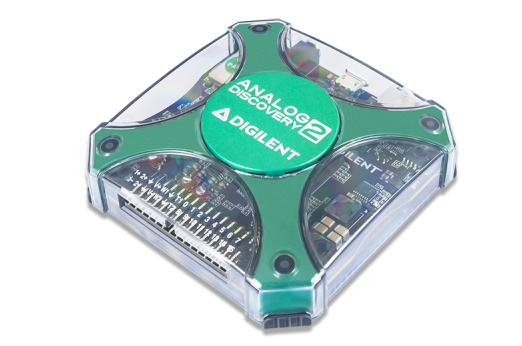By Jean-Jacques DeLisle, contributing writer
For novices, hobbyists, and even veterans, an oscilloscope is one of the most useful tools for designing, diagnosing, learning, and otherwise working with electronics. In previous years, it was difficult for a hobbyist to obtain a quality digital oscilloscope because of prohibitive costs, and even professionals are often limited in equipment access to designated engineering spaces. Much of this has changed since the advent of PC-based USB oscilloscopes, as these devices are lower-cost, have less of a learning curve, and can readily be customized and programmed for a user’s particular needs. This accessibility, along with performance and feature enhancements every year, make PC-based USB oscilloscopes an attractive buy across the board. The following is a brief introduction into a few choice USB oscilloscopes, some with surprising new features.

The Analog Discovery 2. Image source: Digilent.
Digilent Analog Discovery 2
Digilent’s new Analog Discovery 2 builds on the success of the first Discovery module and adds new features and greater performance at only a marginal increase in cost. The Analog Discovery 2 is really an instrumentation lab in a small plastic rectangle; it contains a 2-channel 14-bit oscilloscope function with a sample rate of 100 MS/s, bandwidth beyond 30 MHz, a voltage range of ±25 V, and a max buffer size of 8,192 samples.
This is certainly not a high-performance oscilloscope, but with a price tag of just under $300 and an integrated 2-channel 14-bit arbitrary waveform generator, logic analyzer, pattern generator, voltmeter, programmable power supply, network analyzer, spectrum analyzer, and other features, it’s a useful device to have for all experience levels and projects. The feature extensibility is enabled by an included adapter with lead pins that can easily be connected to a breadboard or other accessories. Beyond its highly dense feature list, the Analog Discovery 2 comes with free software that makes many test setups extremely simple, with a learning curve good for education and industry alike.
SainSmart DDS140
The SainSmart DDS140 is a low-cost 2-channel, 200-MS/s, and 40-MHz bandwidth oscilloscope with a price tag of just over $100. For the budget-conscious, the DDS140 is a relatively rugged device, which also includes the ability to extend its functions with optional signal generator and logic analyzer functions. The included software also comes with an FFT analysis, waveform recorder, and a knob panel display for those that just can’t separate themselves from the traditional twist-and-push oscilloscope interface.
Hantek iDSO 1070A
The iDSO1070A is on this list, as it’s a capable 2-channel, 250-MS/s, and 70-MHz bandwidth USB oscilloscope, with the added capability that it can pair with PCs or tablet devices through a built-in Wi-Fi communications channel and a four-hour battery. Useful for field operation and short-term remote monitoring, an interesting feature of the iDSO2070A is that simultaneous tablet and smartphone viewing is possible. This feature could be useful for tandem fieldwork, troubleshooting, and even education. Under $200, the relatively high bandwidth, battery, and Wi-Fi features of this device could provide a high level of utility for those with unique field or portability needs.
PicoScope 4444
PicoScope is a flagship brand of the PC-based USB oscilloscope family of test instruments and continues to provide enhanced features in its latest models. The 4444 is a high-resolution differential USB oscilloscope with a very large buffer of 10,000 waveforms, advanced math and filtering features, and incredible digital triggering for a USB oscilloscope. The differential inputs are extremely useful when measuring voltages across components, as both differential probe sides are high-impedance, which reduces the common-mode noise of the measurements.
One of the best features of this 4-channel device is that each channel can be outfitted with a different style of probes. Several voltage, current, and adapters are available, from ±50-V non-attenuated voltage probes to 1,000-V CAT III attenuated voltage probes, to 200-/2,000-A AC/DC 150-V CAT II current probes, to 40-A AC/DC 300-V CAT II current probes, and dual/single BNC adapters. On the pricier side for a hobbyist, the PicoScope 4444 can come in under $2,000 or over $3,000, depending on the probe accessories purchased.
Link Instruments MSO-28
The MSO-28 in a compact 2-channel, 2-GS/s, and 60-MHz bandwidth oscilloscope, which is also paired with a time-synchronized 8-lane logic analyzer. The unique setup of the MSO-28 enables each oscilloscope and logic analyzer to be simultaneously sampled and displayed together, ensuring accurate time correlation between the functions. This multi-function device can also trigger on, and decode, SPI or I2C waveforms and includes software features that display FFT analysis and FFT spectrum analysis to 100 MHz.
Unlike many other PC-based USB oscilloscopes, the MSO-28 is also OS-X- and Linux-compatible. This could be a good deal as the MSO-28 is just over $300.
TiePie Handyscope HS6
The Handyscope HS6 is a quad-channel differential USB oscilloscope with 12-, 14-, or enhanced 16-bit resolution capability at 1 GS/s. At around $2,000, this 250-MHz bandwidth oscilloscope is a deal considering that it can be combined through a CMI interface to other multichannel oscilloscopes with a synchronized time-base. An extended memory option is also available, which can provide up to 256 Msamples of memory per channel.
Cleverscope CS448
The CS448 is a quad-channel, 14-bit, and 500-MS/s oscilloscope with the unique benefit of having an extremely high slew rate measuring capability. According to the spec sheet, the CS448 can make measurements on gate drives slewing at up to 1,000 kV/us, and each channel is isolated from each other, and ground, with a 1-kV working voltage per channel. The number of channels can also be extended through optional accessories. At just under $10,000, it’s an expensive USB oscilloscope, except when considering the price of desktop models with similar isolation, working voltage, and other capabilities. For those testing high-power systems, industrial machinery, and motor drives, this could be invaluable.
Advertisement
Learn more about Electronic Products Magazine








